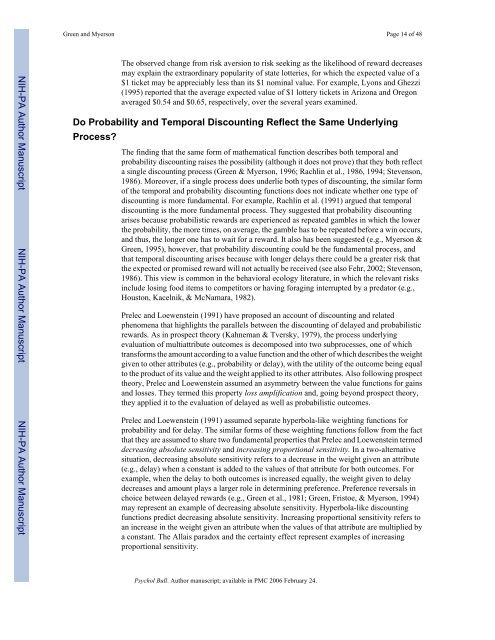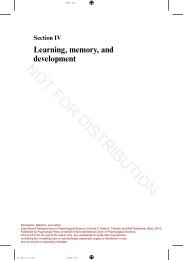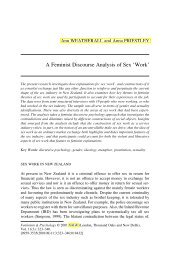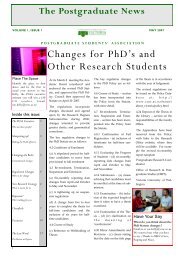green & myerson 2004.. - of /courses
green & myerson 2004.. - of /courses
green & myerson 2004.. - of /courses
You also want an ePaper? Increase the reach of your titles
YUMPU automatically turns print PDFs into web optimized ePapers that Google loves.
Green and Myerson Page 14 <strong>of</strong> 48<br />
NIH-PA Author Manuscript NIH-PA Author Manuscript NIH-PA Author Manuscript<br />
The observed change from risk aversion to risk seeking as the likelihood <strong>of</strong> reward decreases<br />
may explain the extraordinary popularity <strong>of</strong> state lotteries, for which the expected value <strong>of</strong> a<br />
$1 ticket may be appreciably less than its $1 nominal value. For example, Lyons and Ghezzi<br />
(1995) reported that the average expected value <strong>of</strong> $1 lottery tickets in Arizona and Oregon<br />
averaged $0.54 and $0.65, respectively, over the several years examined.<br />
Do Probability and Temporal Discounting Reflect the Same Underlying<br />
Process?<br />
The finding that the same form <strong>of</strong> mathematical function describes both temporal and<br />
probability discounting raises the possibility (although it does not prove) that they both reflect<br />
a single discounting process (Green & Myerson, 1996; Rachlin et al., 1986, 1994; Stevenson,<br />
1986). Moreover, if a single process does underlie both types <strong>of</strong> discounting, the similar form<br />
<strong>of</strong> the temporal and probability discounting functions does not indicate whether one type <strong>of</strong><br />
discounting is more fundamental. For example, Rachlin et al. (1991) argued that temporal<br />
discounting is the more fundamental process. They suggested that probability discounting<br />
arises because probabilistic rewards are experienced as repeated gambles in which the lower<br />
the probability, the more times, on average, the gamble has to be repeated before a win occurs,<br />
and thus, the longer one has to wait for a reward. It also has been suggested (e.g., Myerson &<br />
Green, 1995), however, that probability discounting could be the fundamental process, and<br />
that temporal discounting arises because with longer delays there could be a greater risk that<br />
the expected or promised reward will not actually be received (see also Fehr, 2002; Stevenson,<br />
1986). This view is common in the behavioral ecology literature, in which the relevant risks<br />
include losing food items to competitors or having foraging interrupted by a predator (e.g.,<br />
Houston, Kacelnik, & McNamara, 1982).<br />
Prelec and Loewenstein (1991) have proposed an account <strong>of</strong> discounting and related<br />
phenomena that highlights the parallels between the discounting <strong>of</strong> delayed and probabilistic<br />
rewards. As in prospect theory (Kahneman & Tversky, 1979), the process underlying<br />
evaluation <strong>of</strong> multiattribute outcomes is decomposed into two subprocesses, one <strong>of</strong> which<br />
transforms the amount according to a value function and the other <strong>of</strong> which describes the weight<br />
given to other attributes (e.g., probability or delay), with the utility <strong>of</strong> the outcome being equal<br />
to the product <strong>of</strong> its value and the weight applied to its other attributes. Also following prospect<br />
theory, Prelec and Loewenstein assumed an asymmetry between the value functions for gains<br />
and losses. They termed this property loss amplification and, going beyond prospect theory,<br />
they applied it to the evaluation <strong>of</strong> delayed as well as probabilistic outcomes.<br />
Prelec and Loewenstein (1991) assumed separate hyperbola-like weighting functions for<br />
probability and for delay. The similar forms <strong>of</strong> these weighting functions follow from the fact<br />
that they are assumed to share two fundamental properties that Prelec and Loewenstein termed<br />
decreasing absolute sensitivity and increasing proportional sensitivity. In a two-alternative<br />
situation, decreasing absolute sensitivity refers to a decrease in the weight given an attribute<br />
(e.g., delay) when a constant is added to the values <strong>of</strong> that attribute for both outcomes. For<br />
example, when the delay to both outcomes is increased equally, the weight given to delay<br />
decreases and amount plays a larger role in determining preference. Preference reversals in<br />
choice between delayed rewards (e.g., Green et al., 1981; Green, Fristoe, & Myerson, 1994)<br />
may represent an example <strong>of</strong> decreasing absolute sensitivity. Hyperbola-like discounting<br />
functions predict decreasing absolute sensitivity. Increasing proportional sensitivity refers to<br />
an increase in the weight given an attribute when the values <strong>of</strong> that attribute are multiplied by<br />
a constant. The Allais paradox and the certainty effect represent examples <strong>of</strong> increasing<br />
proportional sensitivity.<br />
Psychol Bull. Author manuscript; available in PMC 2006 February 24.






